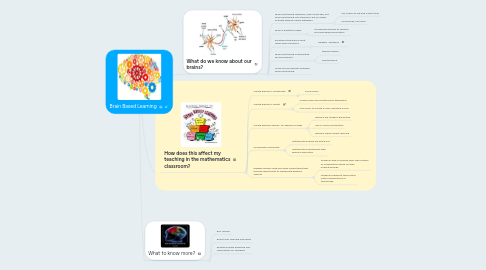Brain Based Learning
por Martine MacKenzie


1. How does this affect my teaching in the mathematics classroom?
1.1. Create places to collaborate
1.1.1. social brain!
1.2. Create places to reflect
1.2.1. unique brain and fostering self awareness
1.2.2. use music to create a calm reflective mood
1.3. Create physical spaces for sharing of ideas
1.3.1. displays are student-generated
1.3.2. use of colour and texture
1.3.3. displays show current learning
1.4. Incorporate movement
1.4.1. mathematical ideas are acted out
1.4.2. mathematics intertwines with physical education
1.5. Engage learners with rich open-ended tasks that provide opportunity to manipulate physical objects
1.5.1. students seek to impose their own system of organization based on their understandings
1.5.2. students represent ideas using math manipulatives or technology
2. What do we know about our brains?
2.1. Brain functioning develops, even as we age, but brain functioning can diminish if we no longer activate specific neural pathways
2.1.1. Yes, teach an old dog a new trick!
2.1.2. You snooze, you lose!
2.2. Brain is a pattern maker
2.2.1. It responds actively to random and unordered information
2.3. Emotions stimulate or shut down brain functions
2.3.1. Relaxed -alertness
2.4. Brain functioning is stimulated by environment
2.4.1. physical space
2.4.2. mental space
